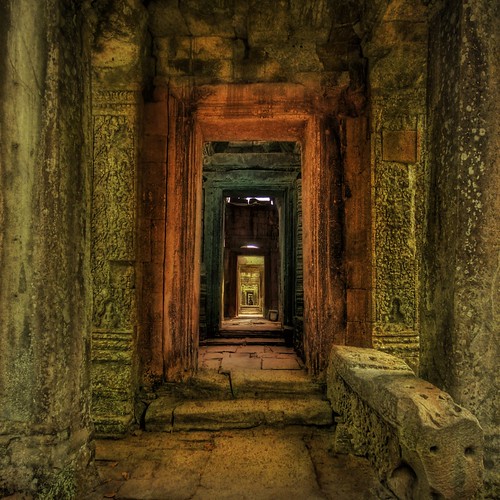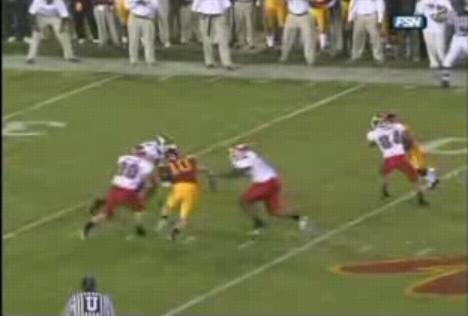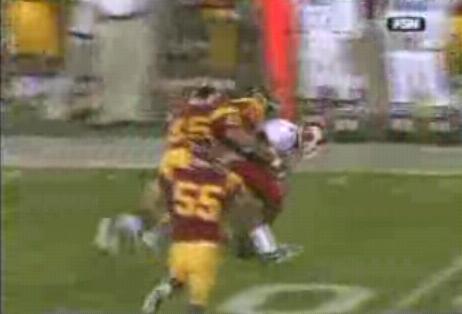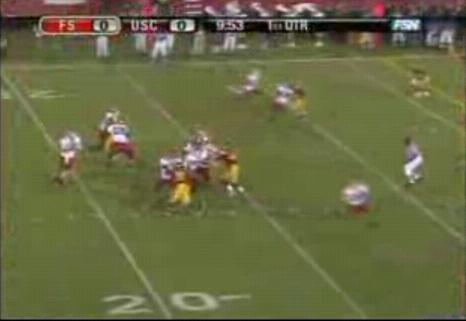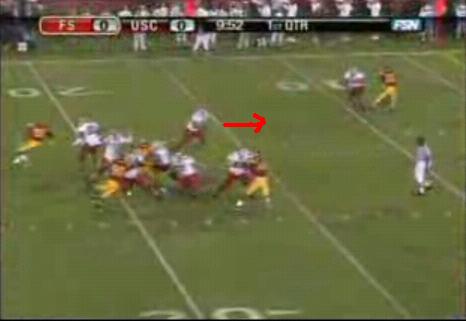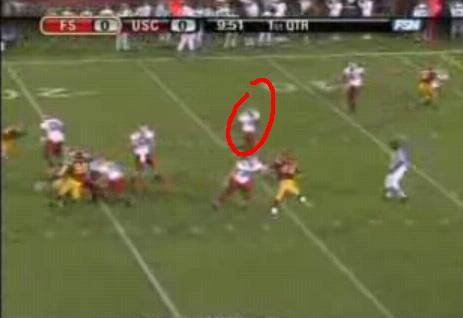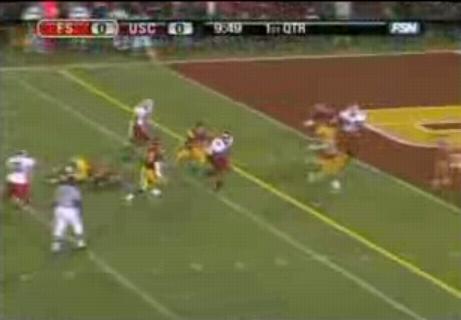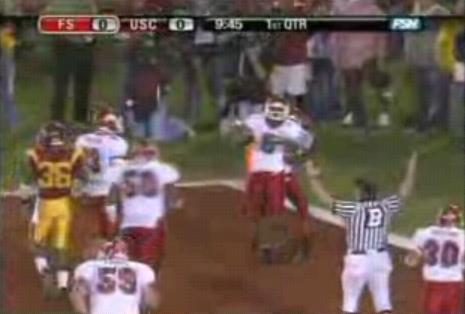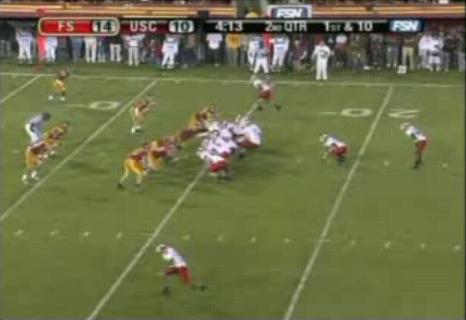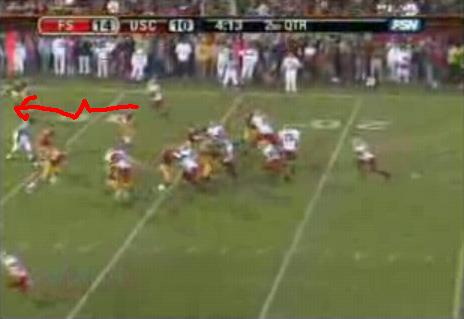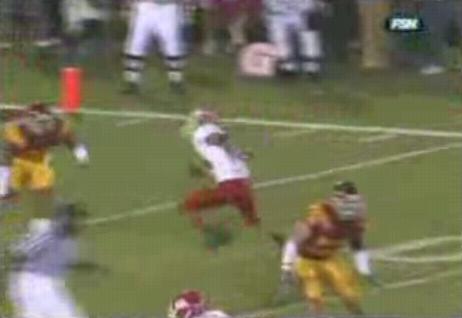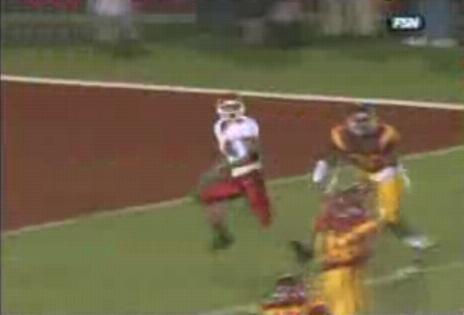Worthless Cal Predictions
 Lots of varying predictions about what Cal’s season is going to look like only confirms one thing: Someone on this list is going to look damned stupid.
Lots of varying predictions about what Cal’s season is going to look like only confirms one thing: Someone on this list is going to look damned stupid.
Phil Steele already set the bar by ranking Cal #2 in the conference, certainly above most normal expectations. However he also had Cal #5 last season, which was as close as any mainstream pundit got to the final outcome. So as they say about fortune and boldness…
Meanwhile, everyone else’s predictions. SI’s great powers of prediction allowed them to do the smartest possible thing: They simply put a list of the 119 Division 1 teams and ranked them 1 to 119 for 2008. No objective criteria, no reasoning, just numbers and teams placed next to them. Cal is ranked right behind Michigan State and even further behind Maryland (MARYLAND?), which makes me wonder if they’re just recapping 2007 performances or really looking at 2008.
Wish I had the time to just compile a list of best college football journalists and do the same thing. I’m sure Stu Mandel’s place on the list will inspire about as much feigned interest as this one.
Of all the projections about Cal’s season from mainstream outlets, the Los Angeles Times comes the closest to nailing the reasons we will succeed this year:
Full disclosure: Cal was not in the top 25 mix until former two-sport Bears star Tony Gonzalez saved a man’s life at a Huntington Beach restaurant last month.
Sometimes it takes heroics to move a school up in the ratings.
Or, sometimes it just takes the setup line Gonzalez provided for a school that otherwise was going to check in at No. 30-something…
“Where was Gonzalez last year when Cal football needed the Heimlich maneuver?”
No doubt that Tony Gonzalez will be flown straight to every Golden Bears game to resuscitate a game that’s slipping away from us. Only his graceful chest pumps kept his team from falling into obscurity, and they’ll be needed again, only this time he’ll be free to smash helmets open and be proclaimed The One.
The New York Times is at its usual self when describing a college football team–exhaustingly thorough. This is good enough to be the 2008 California Golden Bears wiki page:
So how good can Cal be? Not the best in the Pac-10, at least in my eyes, but certainly good enough to win nine or ten games. The good news, at least with the schedule, is that the Bears get Oregon and Arizona State at home; however, the bad news is that the Bears need to go to U.S.C. and Oregon State. While I like Cal, and expect a marked improvement over 2007, I think they are a notch below Arizona State and a full step below U.S.C.
When in doubt, go with the consensus. Nothing remotely controversial or interesting about this one. BOOOO.
Ted Miller opts the safe way too, although he does mention that Jake Locker is the West Coast’s version of Tim Tebow. Yeugh, I hope not. That says more about the West Coast than it does about Jake Locker.
#5) California Golden Bears
Some people have this team a little higher than what we have them, but we just aren’t sure that a team returning 13 starters can make that big a difference on a team that finished tied for 7th last year at 3-6.
The returning starters bit seems insightful…until you realize that only ONE team is returning 15 or more starters in the Pac-10 (The Farm). This same site ranks them ninth in the Pac-10. So experience doesn’t seem to be as big of a deal as you’d probably think.
Then again, this is a gambling site, so it’s probably in their best interest to be wrong.
Finally, from CBS’s Sportsline Editor, who writes perhaps the most asinine article on the topic:
7. California: The Bears need to recover from the epic 1-6 meltdown to close ’07. Try to remember Cal was once the No. 2 team in the country. Then Kevin “Throw The Damn Ball” Riley lost the Oregon State game. Riley is in a battle for the starting job with veteran Nate Longshore. Coach Jeff Tedford gave up play-calling duties, handing them over to new offensive coordinator Frank Cignetti. Which way you going, Bears?
Wow, what penetrating analysis of the state of our football team. Since we were once the #2 team in the country, the veterans will manifest their nostalgia into inner self-loathing. Also some a freshman who made an isolated mistake and atoned for it in the bowl game is actually contending for the quarterback position, so clearly we are in no man’s land. Now some mysterious offensive coordinator will definitely end up sinking this team because really, when you don’t know what to expect, rank them as low as possible.
As usual, the Pac-10 bloggers seem to have their heads on their shoulders the best. Addicted to Quack has an interesting outsider’s opinion that comes closer to my own than anyone else:
3b. California. They have a stellar O-line, which will carry them for much of the season. But they lost huge players at the skill positions. While Cal fans are really excited about Jahvid Best, and the guy is highlight reel waiting to happen, will he be able to carry the load for a whole season? I’m doubtful. Also, all of their running backs weigh less than 200 pounds. Make of that what you will. For the rest of the offense I don’t have a whole lot of confidence in Longshore or Riley. They have a great linebacking corp, though the rest of the defense is above mediocre. They also have an easy schedule. Overall, they have their issues, as does ASU. I feel they will end up in about the same place, with their weaknesses becoming very clear in a couple key games during the season.
This guy seems a little closer to the truth about Cal than anyone else, although he probably underrates the quarterback position (then again, he’s got Nate Costa and Justin Roper, and I’d be pretty jumpy if I had either of those two on my team). And he works for no mainstream outlet at all. Perhaps this says something about the future of mainstream media analysis. Perhaps…
We’ll have plenty more of these worthless predictions as the season goes on. ESPN will probably get an entire column. And my blogpoll numbers are coming soon.
Pathos of Nate Longshore
 It seems football, more than any other sport, provides us with an interminable offseason of endless chatter that rinses and repeats the same old storylines. By the time we get to opening day we’re so exhausted of the cycle we’re just happy for the release of the kickoff.
It seems football, more than any other sport, provides us with an interminable offseason of endless chatter that rinses and repeats the same old storylines. By the time we get to opening day we’re so exhausted of the cycle we’re just happy for the release of the kickoff.
“He played admirably through three and a half quarters most of the time…it was just one thing here or there. During inopportune times, we’d turn the football over. Some of it was [his] responsibility and some of it wasn’t, but he’s the one who shouldered the blame for the whole deal.”
In my first year of covering Cal football fullscale, one question has loomed over everything else, practically sapping all the fun out of covering the team so everyone can play their own version of ESPN talking head. People have obsessed over the topic on message boards and communities alike, exhausting the subject by retreading the same points ad verbatim.
It’s a poisonous thing, a quarterback controversy is, and it can cripple a fanbase like divided leadership can cripple an army. It takes all the entertainment out of football and places the followers of the team in a foul mood. Questions about booing our team members arise for not displaying Pareto efficiency. Ask 49ers fans how they’re feeling this year.
In this day and age, we desire certainty in our decisions and our choices, but when we search for the optimal, we are often not satisfied with the options we’re presented. More importantly, in this empowered age, everyone wants to be right almost as much as they want their teams to succeed. And even if Longshore does have a solid season, you have a feeling he’ll never be fully accepted by a fanbase that favors one quarterback over the other by almost a two-to-one margin.
“He didn’t play perfect. It wasn’t carelessness. It was out of eagerness to be successful and trying to do his part. But there are a lot of reasons for interceptions. Sometimes they definitely fall on the quarterback, but it’s a team sport. It could be a wrong route, a tipped ball or a broken protection. We learned last year that everybody is accountable for our lack of success.”
In the NFL, Donovan McNabb is the posterchild of such frustrations from a divided fanbase. When the spotlight gets bigger, he doesn’t seem to rise along with it, and the murmurs grow to turn loose Kevin Kolb to see if he can get them the extra step. You’d expect more levity in college, but the attitude seems to lean toward instant gratification. Fans should get what they want, right?
Even when kickoff begins, we will not hear the last of Longshore’s detractors. Every day he’ll be questioned, good game or bad game. They will be crowing when he throws a pick, or puts too much air on the ball, or if he tries to float one into double coverage. Again, what has Longshore done for us lately?
Yet you can’t help but feel sorry for Nate in what appears to be a no-win situation; even if he is successful people will gripe that Cal won in spite of him rather than because of him. And in between the mistakes, there will be other throws where you remember what a great talent he is, how sparkling the offense can look under his command.
His vulnerability this season delves beyond the mechanical and physical realm, even beyond his statistics. With Nate no longer the certain incumbent, how will he respond to the pressure of the populace and the determined competitor fighting for the role he was appointed to hold two years back? It’ll be exciting to see the answer as the opening weeks unfold, to see whether imperfect veteran or raw youth prevail.
“Right now is the best time of my career,” Longshore said. “I’m so excited. I think we’re going to surprise some people. There’s focus and an intensity when you’re out there that is unparalleled since I’ve been here.”
(Quotes from Ted Miller’s and Jonathan Okanes’s articles)
The OC (Frank Cignetti at Fresno State, Part II)
After about a month’s break since publishing Part I of the series, we’re going to dive back into the basic tenets of what we can expect from our new offensive coordinator Frank Cignetti. You’re getting all the nice political answers from Frank at Ted Miller’s blog, but here we’re going to dive into the trenches and look back at one of his finer efforts at Fresno State.
We’re going to take a look at the famous Fresno State-USC game of two years back, where the Trojans were severely tested for four quarters before ultimately triumphing over a strong Bulldogs effort.
Warning: These images are a little blurry because they’re YouTubed. This post will have an analog feel to it.
People who think Tedford’s offense was predictable might be a little disappointed by the standard sets that highlighted the Bulldogs’s 50-42 defeat. Nothing much stood out to me that seemed different from what Tedford ran last year except some occasional spread movement, so you can probably expect many offensive sets that remind you of the 2007 season; you can only hope they run better then they did last year.
Play 1: The wide receiver screen (Click here to view the photo set)
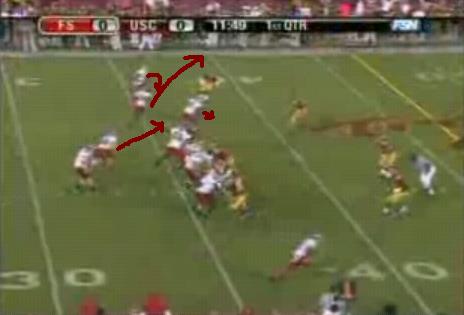
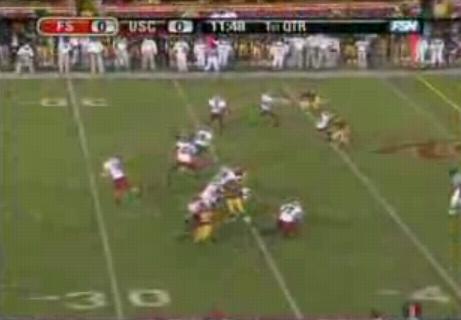
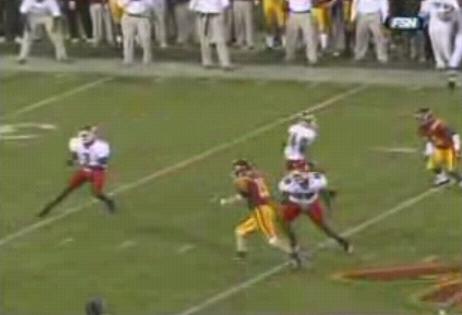
Watch as the wide recievers set up to the outside and take a look at how the Fresno State players (especially receivers) set up for blocking schemes. Notice in this sequence how the Fresno State players move in different directions, with the offensive linemen moving laterally upward.
You’ll see basic Xs and Os football–the wide receivers running excellent routes, the fullback coming in and bailing the wide receiver out of a failed block, and the wide receiver exploiting the gap for the first down. Straightforward, methodical, and not at all exciting for a fairweather football fan. But I do like the way that the receivers are set up this year, who are more physical and able to block up at the line of scrimmage.
Play 2: Spreading the field (click here to view the photo set)
Again you see another example of the screen offense with a throw up the middle in a shotgun set; Cal utilized plenty of lateral throws to the outside last year to try and exploit the stronger front sevens the Bears smaller offensive unit would face later in the season. Here you see an interesting variation of the screen, with the three wide receiver set spreading the USC front in route to scoring their first TD. Whether the first option was the screen can be questioned, but Pinegar clearly adapted well on the fly.
It’ll be important to see how Jahvid Best develops utilizing these screen attacks, since he’ll be the purest speedster we’ve had in the Tedford era. How good our receivers block could determine our success in the screen game since our offensive linemen will be experienced enough to create holes for Longshore and/or Riley to dart it to Best on the side or middle routes. There were a lot of plays like this in the USC game, where Trojans dropped deep into coverage and the ten yard routes were available to Cignetti’s backs and tight end.
Play 3: Thread the needle (click here to view this photo set)
Absolutely the strongest facet of this offense, it relies on great precision of running routes and placing the ball in the right spots. Automatically you can think which Cal quarterback would have the advantage here.
Here you can see the receiver Joe Fernandez thread right between the corner (freezing him with a quick shift in direction that fakes him right and takes him left) and the safety in precise fashion, allowing the Bulldogs to take a 21-10 advantage in the 2nd quarter.
This is the type of play you can feel good about Nate Longshore running when healthy. Riley has been working on this part of his game in the fall; we’ll see how much these type of plays factor into Cal’s offense. But this offense is pure nuts and bolts, with a tad of creativity waxed into the proceedings. We’re returning to basics and that might not be such a bad thing–this will not be the Dunbar Experience Redux.
Expect many variations of these three plays this year, rinsed and repeated with some unconventionality mixed in. It looks like another promising year for the Cal offense.
Pac-10 Quarterback Analysis, Part III: The Situation Room
(Read Part I on Longshore and Part II on Pac-10 QBs here)
Seems people demand it, but it looks like it’s time to figure out what Nate Longshore and his Pac-10 bretheren are truly capable of situationally. You’ve probably read about the situational practices Tedford is placing his quarterbacks through and how each of them fared (and some board posters have gone quickly into armchair mode: “ho ho, I was right, Nate can’t even do it in the imaginary 4th! HO HO!”).
Far more of interest to me than the passer rating is not the interceptions but percentages, particularly completion and first down conversion. Interceptions suck, but they are a small percentage of the throws a quarterback commits. Touchdowns are great, but they are on average only slightly larger in number for a quarterback than interceptions. Conversions though? There are plenty more of those for a quarterback to convert.
How many more times does Longshore succeed in converting for the Bears, keeping the offense? Let’s take a look at how often each Pac-10 team converted first downs in every regular down situation (4th downs will not be counted for this particular measurement, the sample size is way too small; I might add it into 3rd down stats later on, but for now we’ll stick with the first three down format). Click the image below for a larger view.
For people who’ve been wanting some statistical evidence that Kevin Riley is a superior quarterback, this is the best example so far. In a limited sample size (only 15 attempts on 2nd down and 16 attempts on 3rd down) Riley not only completed close to two-thirds of his 2nd down and 3rd down throws, he turned over half of them into first downs, a trend that clearly places him above the other Pac-10 QBs. But again, this sample size is limited, so you’d figure of all the quarterbacks it’d buck the trend more so than quarterbacks who played every week. Nevertheless, very impressive numbers.
Riley had a terribly small 3rd down set, so it would have been silly to break it down stat by stat (just for the record, he was close to perfect on the 8 short passes they throw, but only had one completion above a 3rd and 7+ situation). Not so Longshore. You can see that the 2006 stats are just off the charts–of the quarterbacks who were starters the majority of the season, only Dennis Dixon last year (that season is just nutty to look at for Dennis) had a better season converting 1st downs on 1st and 2nd down situations. The numbers were near the top on 3rd down, and even though he had a strange dip on mid-range 3rd down conversions, he was near the top in every other category (and was the best on 3rd and long passes).
2007 was a much different story for Nate. Although his conversion rate only dipped slightly on 1st down situations, they were sharply down on 2nd down and a little below the mean on 3rd down. He only converted 4 first downs and 1 TD on 14 attempts on 3rd and short yardage situations, the worst conversion rate in the Pac-10. His numbers were down across the board, except an amazing sharp increase on 3rd down and 4-6, his worst area in 2006.
Now if you add in touchdowns to the equation, you get a more interesting depiction of how strong Cal’s quarterback seasons are with respect to the rest of the Pac-10.
Riley’s numbers go way up for 2nd and 3rd downs because of the five TDs he threw in that short period of a game and three quarters. Touchdowns wouldn’t have as much of a factor on quarterbacks with a wider set of starts. Longshore’s 2006 numbers remain fairly steady, but his 2007 numbers are in the bottom tier now. Again, there are certainly many factors for why the 1st down conversion rates are down, but there’s no doubt Nate was not performing up to his 2006 form in terms of keeping his offense on the field.
Dennis Dixon had a wild ride with the Oregon Ducks; his season was pretty much like Longshore’s 06 campaign, except it even looked more like a sugar rush. There was no correlation at all between yardage and distance for Dixon, as his numbers were sky-high in 3rd and short range (67%), stifled in the midrange 4 to 6 yard area (31%, last among every Pac-10 quarterback), unearthly on 3rd and long (61%, 14 points higher than second place Longshore’s impressive 47%), and dipping back to about average on 3rd and long. It’s hard to determine if Dixon has the consistency with his arm to be a surefire quarterback with his arm, especially the way he seems to struggle converting the midrange throw, but in the longer situations he appears to thrive.
Rudy Carpenter’s numbers defy logic and reason; his numbers go up from 2nd down, to 3rd down overall, to 3rd down short, to 3rd down middle, to 3rd down LONG. It’s a slow and steady progression, but among all the Pac-10 quarterbacks last year Carpenter seemed to perform the most admirably, completing over 60 percent of his passes on 3rd down and converting close to sixty percent of those passes into first downs. I might be coming around on Carpenter, who just seems to need adequate protection around him to get his team in the Rose Bowl direction (47 attempts from 3rd and 10+ was just too much for Carpenter to overcome when his team fell behind against better teams).
John David Booty is unsurprisingly the most surehanded of these quarterbacks–it’s almost depressing how boring and steady his statline is. He doesn’t finish first in any category outright, but he’s in the upper tier in every category, especially in the 3rd down and under 10 yards range for 2007 QBs (3rd, 2nd, 4th respectively). Not a great quarterback, but consistent enough to close the door. The steady pace kept him from throwing many 3rd down balls too–only 84 pass attempts on 3rd down, second to Dixon’s abnormal 63 (for perspective, Longshore threw 110 times, Carpenter 114 times, Tuitama 139 times).
Mark Sanchez is a strange quarterback to figure out. On the one hand he was awful on 2nd down, throwing 4 picks and around 54 percent of his passes; on the other hand he converted over 51 percent of his throws on 3rd down into first downs, a number only breached by Kevin Riley. Again, you have to think the limited experience and the varying nature of his opponents (Arizona, Notre Dame, Oregon) contributed to these numbers, so we’ll have to call them “inconclusive”. He definitely converted better on the limited opportunities he had on 3rd and long than Riley (67% completion rate on 3rd and 7-9 yards, 13 completions on 18 attempts and 1 TD on 3rd and 7+ yard situations overall for Sanchez, compared to Riley’s 3 completions on 9 attempts and 1 INT on 3rd and 7+ situations)
Oregon State Beaver fans seemed to be pretty happy with what they see out of Lyle Moveao, and the stats seem to confirm this. In the four games he played he actually was stronger on 1st and 2nd down than Booty, and he was around the mean on 3rd down. Compare this to Sean Canfield, who was next to last, third to last, and last on 1st, 2nd and 3rd down conversion rates. Not a surprise that Moveao will be taking the helm in Stanford Stadium opening night.
Willie Tuitama pretty much is the mean in this graph. He’s not great in anything, but he’s not bad either. His numbers are indicative of a typical Sonny Lubbick crazy-go-pass offense designed to destroy all lateral arm movement. I still don’t know what to make of Tuitama, who seems to do just enough to get by. Even Alex Brink performs better than him on 3rd downs, which I didn’t even know was possible. Brink was actually an impressive 3rd down passer, and sat right near the top in every category, making his NFL draft exclusion a little surprising–wouldn’t you want a guy who could convert over 50 percent of his typical 3rd down situations? His Washington State team was white bread last year and he still managed to chug along on the ever-so-crucial down.
Which finally brings us to Jake Locker, who sits near the bottom right along with his last place Huskies. It’s strange that I feel threatened by a guy who can’t throw deep (last on 1st down conversion rate), can’t really throw short (next to last on 3rd and short conversion rate, and really can’t convert at all. He’s like a crappier version of Dixon. Will he manage to improve his arm strength in spite of his early injuries? It remains to be seen.
In the next post in the series, we’ll get to the crucial question of clutch. How well does Nate Longshore fare against the rest of his compatriots in the 4th quarter, and how well do all Pac-10 quarterbacks fare in come-from-behind situations? And perhaps we’ll analyze how much Longshore’s crucial 2007 INTs can be blamed on Nate alone and how much of the onus falls on his teammates as well.
Any parting thoughts on these situational stats, leave them in the comments as usual.
(To view the spreadsheet with all the Pac-10 quarterback data, click here)
The Open Door Policy
I’d like to talk a lot about practice or the overall merit of it; not that I think it’ll have too much correlation with how Cal performs this season. But of course the usual rules are in effect–practice is closed except to a few beat reporters like Okanes from the Contra Costa Times and Andrew Kim from the Daily Cal. So my opinions of our team practice and play will be severely limited at the moment. I know it’s frustrating to pass by Memorial Stadium every few days and not be able to catch a glimpse of what’s happening inside.
It is always a struggle for a leader to decide how much of his strategy and decision-making should be made public. All too often the secretive side wins, a Cold War mentality emerges of what information should be concealed. Sometimes it works, sometimes it doesn’t.
On the flip side, there is the ability for some to release themselves from that burden, to liberate themselves from the worries of control and spin. Giving the public glimpses of the possibilities of perfection has been all some fanbases have needed to feel at ease about the upcoming season and whatever result presents itself. USC has held open practices for years, as had Florida, as has LSU, as has Texas. Who’s won the last four titles? The Trojans lost to Stanford, lost to Oregon, yet came right back and charged the gauntlet in their final five games. The confidence was not only internal but external.
I think the future is in openness, especially at the amateur level. Openness makes fans amenable. In college, fans exist like a support group, a camraderie of fellow students and past alum hoping desperately for their teams to succeed. Opening up the spirit of the team gives them a close-up look of and it makes them feel like they’re involved in the process.
More importantly, openness would relieve pressure on a team nursing high expectations. Last year’s team felt the pressure of the closed environment, internalized the issues and did not come together when adversity stared them in the face. Openness eases that burden; closure reinforces it.
That being said, I don’t think it’ll have that much of an impact come kickoff time this year. We’re entering a tabula rasa season, where nothing is to be expected or anticipated. Our players are not as talented at first glance and definitely not as heralded, so we’re starting anew with the hopes that our new team will grow and hopefully stumble into the grand prizes our fans so desire.
The question is, when Cal is again in a position to challenge for great things, will we open the doors to what’s ahead for us or lock them to keep anyone else from seeing it?
Leave your thoughts on open/closed practice in the comments.
The Longshore-Riley-Mansion Debate
MODERATOR: Ladies and gentleman, welcome to Wheeler Auditorium for tonight’s momentous Cal quarterback debate. Remember, Coach Tedford is monitoring this very closely as a testament to your strength of character. No personal attacks, let’s keep this civil and on-topic as to why each of you should be starting next season.
Mr. Nate Longshore, my first question goes to you. You have been under fire from a disgruntled fanbase that is not confident in your abilities to lead a team to a conference championship. How do you respond to your detractors and what have you done to ensure that you regain their confidence as a leader?
LONGSHORE: Let me first say hello to everyone, and congratulations to my younger rival for getting this far in this contest. I don’t think either of us thought would get this far, and I’m sure neither thought we’d be fighting one another this deep into August without a resolution. It’s a testament to our desire to win.
Everyone knows what to expect of me. When I’m healthy, I’m unstoppable. When I’m not healthy, I have the experience to know how to handle adversity. I’ve been tortured with injuries, with pain, imprisoned in a toxic locker room that seemed to turn on me because I wouldn’t get healthy. I realize I’m a bit of a maverick, but it’s not like I’m not trying out there. Did receivers also not run routes? Did we forget how weak our defensive front was? So many things went wrong last year yet the fans took most of it out on me.
Here I am again this year though, right in the thick of things. And I’m not about to be counted out. I’m fairly confident that I’m a good quarterback and can run Jeff Tedford’s offense to the best of my abilities.
MODERATOR: Mr. Riley, your rebuttal.
RILEY: Before I begin, let me also start by saying how happy I am to have Nate as a competitor and opponent for this job, who I believe is a decorated quarterback of many momentous campaigns. He has fought in tough battles, and has definitely suffered many scars from those conflicts. For that I’m honored to be a part of this debate and this race for the quarterback position.
But we have to remember that we are working to build a team that is neither black nor white, but gold and blue. It is where no colors matter but the jerseys we put on every day.
LONGSHORE: (flush, interrupts) I didn’t talk about race, Kevin.
RILEY: (continues unabated after the brief interruption) I believe that Cal is ready to embrace that. I’m ready to be the change that we wish to see in the world, to bring Cal football to that next level. We have to change the culture of our team in order to raise it to the next level.
LONGSHORE: Uh, Kevin, culture? You mean instead of listening to the heartland country beats we should be listening to more AC/DC?
RILEY: I didn’t exactly say that Nate…
MODERATOR: I’d like to give Mr. Mansion a chance to speak. Mr. Mansion.
MANSION: Are we really going to let these two quarterbacks duke it out without letting the minority voice be heard? Don’t we see the tyranny in a two-quarterback system? Damn man, where I’m from in Texas, we make sure that the quietest voices are heard day in and day out.
MODERATOR: (pretending to listen to Mansion, then moving on) Mr. Riley, can you elaborate on how exactly you plan to change the culture of Cal football?
RILEY: We have to see that the system in place right now is in need of repair. We are playing games we cannot win right now, against opponents that do not understand why we hate them so much. There is so much pent-up frustration from 50 years of Pac-10 disappointments that we are taking it out on other fanbases, that we are letting ourselves be caught up in the Monday Morning Quarterback style of analysis that has hampered our enthusiasm for the game in the desire to feel like we know it better than everyone else.
LONGSHORE: Sigh. Yes, I’m well too aware of the talking heads of the world. It’s nice to hear I suck so much; I wonder if that’s how you treat your friends everytime they fail at something important to them. Much easier to sit on your couches and type 500 posts about me, isn’t it?
RILEY: This is one point where my competitor and I agree; that we cannot let ourselves be drowned out in the sea of hostile democracy. We have to reach across to one another and realize these are just opinions, and the true battles will be waged on the football field, not on the message boards of the world.
LONGSHORE: Don’t be coy Kevin. If the public had their way you’d be starting and I’d be packing my bags for Peru for two years. (uneasy laughter in the audience) There’s a reason we have responsible people running our competition. It’s a perfect system in place to determine who will be our starter.
MANSION: (interjecting angrily) The system is broken! It needs to be fixed! The Pac-10 allows monopolies like USC to run amok! We cannot stand for this!
MODERATOR: I’m going to have to interrupt you Mr. Mansion. Mr. Longshore, one of the biggest criticisms about your game is your inability to deliver big time in the clutch. People say you don’t have “it.” Do you have a rebuttal?
LONGSHORE: “It”? What is it? I don’t understand why people think I need to do more than just run the offense; I also need to step up and make big plays right with my playmakers. Yet when I’m healthy this team has gone 15-3. In terms of mechanics I’m not much different from Peyton Manning, who stands in the pocket, sidesteps defenders and lasers the ball to the receiver. Manning won a Super Bowl too, and that was with plenty of mediatypes saying he was no good.
People say Brett Favre has “it”. He’s been a quarterback who’s made great plays, with an occasional firebomb performance that warmed everyone’s hearts. He’s also made plenty of crappy ones, some of which cost his team big time. Having “it” is not the only thing you can use to decide who should be snapping under center.
Are you guys going to give yourselves over to passion with a few fiery performances? What has my friend proven other than winning a meaningless bowl game with nothing to lose and showing the potential (repeat: POTENTIAL) to win a game that would’ve put us at #1? He has shown flashes of brilliance, yes, but are you just going to hand over the keys to an unproven commodity who has shown us nothing else?
MANSION: (interrupting before Riley can rebut) What has football position battles shown us about the fairness of the NCAA? A corrupt system that feeds us the worst possible product? Don’t we realize how we’re letting ourselves be controlled by the petty squabbles when we should be focusing on how bigger institutions are making it hard for the final outcome of a season to satisfy college football fans…
MODERATOR (silences Mansion’s mic): We’ll take a break at this point and come right back with more, here from Wheeler Auditorium.
Do you have any questions in this live debate? Leave them in the comments; they will be answered in the next segment, to be aired next week.
Give Me Bad Numbers: Pac-10 Quarterback Analysis, Part II
The college quarterback rating formula is absurdly reductionist. It overvalues completions rather than completion percentage, it overvalues touchdowns rather than drives, it overvalues interceptions by placing them all at the same value, and it really really really overvalues yardage without analyzing yards after catch. Almost all of the things plugged into the formula represent outcomes rather than processes, and you probably know how I feel about that.
Basically, if you throw the ball a lot and pick up tons of yardage, you can expect to get a +100 passer rating as long as you don’t toss four picks along with it. So you can see that there are too many inadequacies with this system–they don’t really provide an accurate measure of the quarterback’s performance, just a general overbrushing stat to please the fan.
And just by looking at each of the Pac-10 quarterbacks who started this year, you can say the same thing about their relative performances. Note that the Pac-10 defensive ratings are ranked from best to worst.
Here’s the actual graph.
Oooh. Colors. Probably can’t make good sense of it though, so I’ve separated it up, player by player.
Rudy Carpenter (ASU): Mr. Fantastic
“Them QB ratings love Mr. Carpentar. I tell ya sir, he is a good ol-fashioned quarterback. Definitely gonna be somethin’ in the NFL one day, I say. He got what it takes if them stats are a good reflection. Yessir you gotta fine young man….”
I mean look at those stats. All 9 games played in conference, all above the record. Yet you can stare at those stats and find something wrong if you think back to the results of the 2007 season.
(think about it…)
(think about it…)
According to the brilliance of the quarterback rating system, two of Rudy Carpenter’s three best efforts came against USC and Oregon. That sounds about right, because Carpenter and Arizona State lost BOTH of those games by double digits. Hm, wait a minute, that doesn’t sound right at all.
Meanwhile, he played about at par to the other six Pac-10 passing defenses he faced. He won all of these games fairly handily. So when he played at his worst his team won. Makes plenty of sense huh?
Nate Longshore (Cal) and John David Booty: I AM THE MEAN!
Did a whole post on Longshore (re-read it here). The one thing to notice is his numbers are at par against the best opponents, and only bipolar during Cal’s last two games against Washington (great) and Stanford (yugh). Not too much to retread on here.
Interestingly enough, the also-injured John David Booty did not deviate much from the mean. However his best performance came against the best; although he did not play against Oregon or Arizona (two of the top 5 passing Ds in the league), he thoroughly obliterated the Sun Devils on Thanksgiving night. Otherwise, he had so-so games against UCLA, Oregon State, and Cal, and was just bad versus Stanford (loss) and Washington (nearly lost). So what was the difference between USC and Cal if not quarterbacks? Defense, of course.
Dennis Dixon: Amazing upside potential
Dixon’s stats are just incredible.
What’s Coming Up
As we’re now only weeks away from the season opener, we’ll be going to shorter posts every day. I’m setting up a rough schedule of what the next three months of Bears Necessity will look like, and hopefully I will adhere my best to it, with an occasional surprise here and there. I also will try to organize a part of the sidebar with a better organized archives section.
What you can expect to see:
- Indepth breakdowns of our opponents
- Pac-10 comparisons of our units (who has the best o-line, running back corps, etc.)
- Interviews with fans on various message boards
- Statistical gobblygook
- Some gamefilm here and there, although after some brief reviewing of the material I realize I have a lot to learn from my original attempts.
- Me and Nestor dueling in the Octagon (our agents have yet to approve this)
- Breakdown of as many Pac-10 games as possible.
- A play-by-play analysis of EVERY Cal game this year (this project might not be completed until the offseason, since I’m too poor to afford Tivo at this moment).
A rough liveblogging schedule should also be unfolding. You might see an amazing amount of crappy Tuesday night MAC and Friday night WAC games being covered.
I think this is going to be a very entertaining year, so I plan to throw myself into covering Cal football with as much effort as I can sustain while making very little money ($20 a week baby! I can afford the nicest looking box at People’s Park!)
I think this is going to be a great season, so I’m looking forward to covering it in greater earnest. GO BEARS!
The Big Play
I hate this term. I hate this term more than Baby Boomers lamenting the thuggery of the NBA (and I really love basketball). I hate this term more than that dude from Florida with the billboards. I almost hate it more than that turdbox Skip Bayless. This term has dulled the minds of sports-loving Americans everywhere, reducing the mental workings of the game to its basest clichés of observation and discussion.
There is this constant myth that prevails throughout football, especially in the NFL but slowly filtering down through the college levels, that games can be decided with the big play. Just as in baseball with the glory of the home run, the football quarterback has been harkened to as a figure of glory because of the possibilities that arise from his position. He is the center of attention. He holds the power to change the game by the very essence of his nature, a figure who can inject hope as quickly as he can be assigned blame.
But fans love guys who make “big plays”, because it’s much easier to discern value from big plays than through consistent production and ability. Like people who believe the actual act of getting on base is more important than the archaic nature of stealing and getting on base.
Big plays, though, are moments. They should be a part of the game but should not derive true value. A person who makes lays makes good ones and bad ones, and often you want someone who can mix an dmatch. but it was a moment, a discrete period where two athletes brought themselves to a common goal. It wasn’t a big play as much as it was a necessary one, one to keep the goals alive. The defense did the brunt of the work. Yet the majority of the glory from mainstream media typesgoes to the QB and his trusty receiver. Michael Jordan wasn’t a great basketball player because he made big shots to end games. He was a great basketball player because he shot an efficient 50 percent from the field…as a 2-guard…facing constant double and triple-teams during his prime…and developing effective countermeasures to make those defenses moot.
But this myth of the big play persists, because it’s easier to find these defining moments of conclusion and acceptance, focusing on outcomes over processes. It’s why you see pernicious stats like 15+ and 25+ appearing, only to amplify that yes, your quarterback is capable of throwing it deep. That he can make your life easier with one snap of the button. How do you think Rex Grossman got into the league?
And yes, I’m talking about Riley v. Longshore. Riley has shown that yes, he is capable of big plays, bringing the offense to unbelievable outcomes, but only by being handed the Golden Ticket of the most talented offense to ever run through Strawberry Canyon. Riley had four NFL worthy receivers and played free-for-all offense only when his team was in huge come-from-behind situations. But his big plays were, just like Manning-to-Tyree, necessary. It wasn’t like the game was tied or the Bears were trying to clinch the game. This was to come back and win in dire circumstances. These plays demanded success or the result would be a loss.
So while you may think Riley deserves to start because he’s able to come-from-behind, has anyone considered the fact that he might not be that good at holding a lead either? We only have one side of the coin with Riley, just like we flip the coin with Longshore and see his 4th quarter stats. As open season begins and the competition between the two heats up, we’re going to find out which side lands face-up.
Share your thoughts of “being clutch” in the comments.
(Image credits here and here)
What Type of Wine is Cal Football?
EDSBS Live had this radio special from a few weeks back dedicated to wine analogies for football teams, and although I could barely tell (my knowledge of wines is basically what I did when I got a C on my homework) what the wines were (Here are some sample answers from an Ole Miss fan). Considering Cal fans are connoisseurs of the classy liquors that suffuse this age, I polled the loyal fans at The Bear Insider to figure out what wine best describes our team.
“Notes of patchouli, cannabis and oak. The 2007 is aggressively forward but finishes poorly.”
“This year will be Beary Good! Intense and full body…with a smoooth finish.”
“Bearitage is a traditional blend of Cabernet Sauvignon and Merlot with
an always enlivening infusion of Zinfandel. The wine is bright and luscious
with ripe cherry and pepper nuances. It has healthy tannins and is
ready to drink tonight. ”“During the dormant period of 2001-2002 and experimental graft was made on the ‘old vines’ in Strawberry Canyon. The experiment was amazingly successful as Holmoe virus was wiped out over the course of one winter. We went from one-buck chuck to favorable recognition at many state fairs. Balance was the key to this new found success as the new vintner emphasized both the air and the soil (ground, if you will) to develop a product that competing wines had to strive to match. Blended to be a classic Cabernet, in 2007 some puckery syrah snuck into the vats and many found the vintage undrinkable as the wine matured, but with the addition of some beaujolais at the last minute the vintage was at least salvaged. Look for this year’s product to return to the classically balanced Tedford style, with backbone and staying power complemented by the presence of velvety overtones.”
“Terroir of the Bears
Hello. Bordeaux and Burgundy are two of the most famous of French appellations and perhaps the best known wine regions on Earth, and if you know wine, it isn’t difficult to list the Italian counterparts: Barolo/Barbaresco and Brunello di Montalcino — the pride of Piemonte and Tuscany.So far that’s four. I think the fifth wine region is the best: Bandol, the Mediterranean seaside region of Provence, FR., located between Marseille and Toulon.
Bandol wines have feral aromas of leather and the maquis, a fragrance of wild herbs, and minerality, with flavors of currants, eucalyptus, violet and liquorice when young, and red fruit, Morello cherry, jam, spices, truffle and hummus when aged. It reflects the sun-baked terroir.
Bandols possess the complexity and flavor shared by few wines.”
“While we don’t get the press of Napa Valley Cabernet Sauvignon (SEC), many prefer the subtleties and exuberance of wine made from premium Pinot grapes, and many of those “in the know” even prefer the stylish Pinots (Pac-10) to bloated, high-alcohol Cabernets.
There were some problems with the previous winemaker, but since Vigneron Tedford has taken over our estate vineyards are producing better fruit than ever.
Look for big things from this estate – 92 points and trending upward.”
Since I assume many of the readers are of many tastes, I’ll make the category broader and open it up to wider debate–what type of liquid courage best describes the California Golden Bears?




